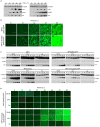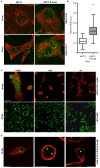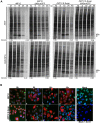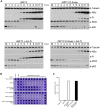The consequences of reconfiguring the ambisense S genome segment of Rift Valley fever virus on viral replication in mammalian and mosquito cells and for genome packaging
- PMID: 24550727
- PMCID: PMC3923772
- DOI: 10.1371/journal.ppat.1003922
The consequences of reconfiguring the ambisense S genome segment of Rift Valley fever virus on viral replication in mammalian and mosquito cells and for genome packaging
Abstract
Rift Valley fever virus (RVFV, family Bunyaviridae) is a mosquito-borne pathogen of both livestock and humans, found primarily in Sub-Saharan Africa and the Arabian Peninsula. The viral genome comprises two negative-sense (L and M segments) and one ambisense (S segment) RNAs that encode seven proteins. The S segment encodes the nucleocapsid (N) protein in the negative-sense and a nonstructural (NSs) protein in the positive-sense, though NSs cannot be translated directly from the S segment but rather from a specific subgenomic mRNA. Using reverse genetics we generated a virus, designated rMP12:S-Swap, in which the N protein is expressed from the NSs locus and NSs from the N locus within the genomic S RNA. In cells infected with rMP12:S-Swap NSs is expressed at higher levels with respect to N than in cells infected with the parental rMP12 virus. Despite NSs being the main interferon antagonist and determinant of virulence, growth of rMP12:S-Swap was attenuated in mammalian cells and gave a small plaque phenotype. The increased abundance of the NSs protein did not lead to faster inhibition of host cell protein synthesis or host cell transcription in infected mammalian cells. In cultured mosquito cells, however, infection with rMP12:S-Swap resulted in cell death rather than establishment of persistence as seen with rMP12. Finally, altering the composition of the S segment led to a differential packaging ratio of genomic to antigenomic RNA into rMP12:S-Swap virions. Our results highlight the plasticity of the RVFV genome and provide a useful experimental tool to investigate further the packaging mechanism of the segmented genome.
Conflict of interest statement
The authors have declared that no competing interests exist.
Figures








References
-
- Plyusnin A, Beaty BJ, Elliott RM, Goldbach R, Kormelink R, et al. (2012) Bunyaviridae. In: King AMQ, Adams MJ, Carstens EB, Lefkowits EJ, editors. Virus taxonomy: ninth report of the International Committee on Taxonomy of Viruses. London: Elsevier Academic Press. pp. 725–741
-
- Madani TA, Al-Mazrou YY, Al-Jeffri MH, Mishkhas AA, Al-Rabeah AM, et al. (2003) Rift Valley fever epidemic in Saudi Arabia: epidemiological, clinical, and laboratory characteristics. Clin Infect Dis 37: 1084–1092. - PubMed
Publication types
MeSH terms
Substances
Grants and funding
LinkOut - more resources
Full Text Sources
Other Literature Sources
Medical

